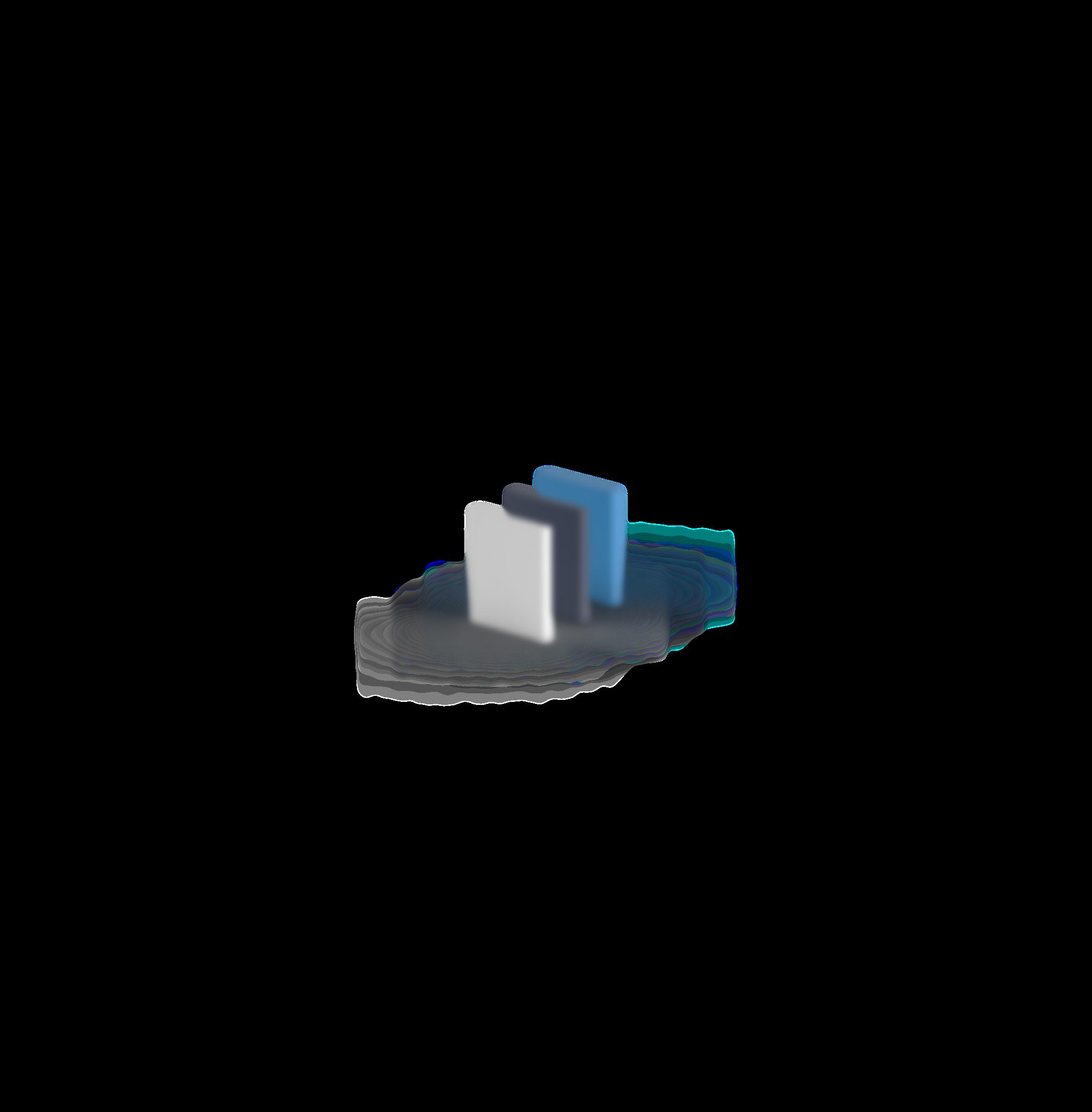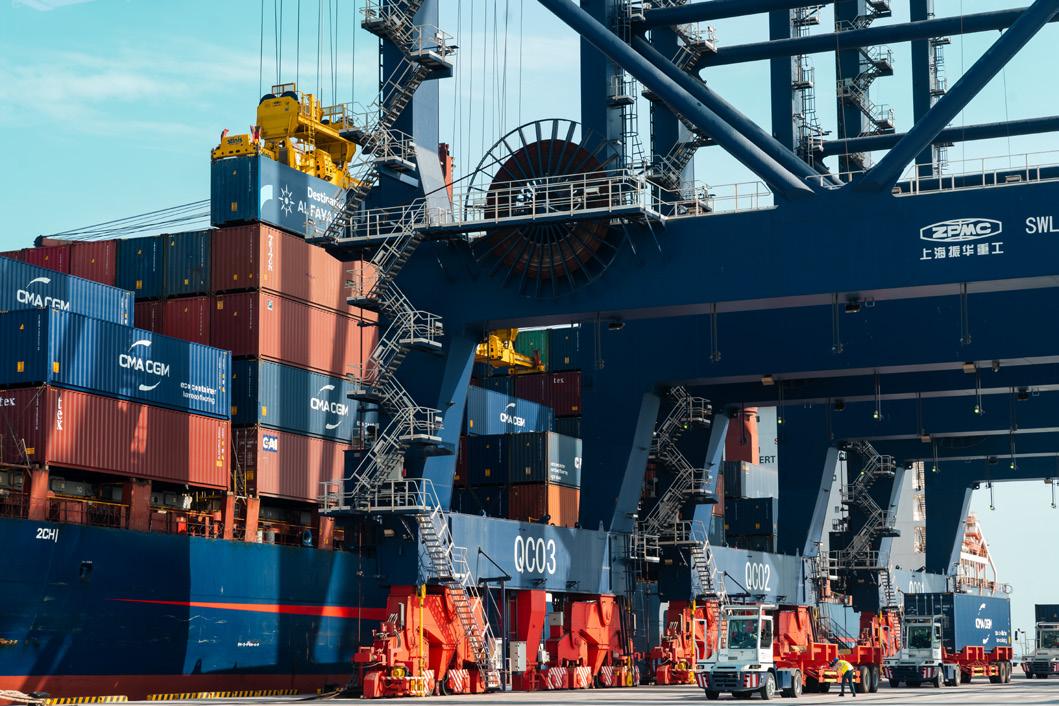

Building Human-AI Teams
AD Ports Group's Blueprint for Tomorrow's Workforce
BLUEPRINT
Authors Mohamed Jamal-Eddine, Group CIO
Sultan Al Ghaithi, Group CHRO
Executive Summary
Top Takeaways
1 0 0 2 0 3 0 4
AI Agents are becoming digital colleagues.
They will complement humans by handling repetitive, data-heavy, and analytical tasks, while employees focus on creativity, judgment, empathy, and strategic leadership.
Workforce transformation is inevitable.
Hiring practices, job descriptions, and required skills will evolve toward adaptability, digital literacy, and human-AI collaboration.
Technology readiness is as important as people readiness.
Secure, scalable infrastructure and responsible AI governance must align with talent development and cultural adoption.
AD Ports Group is pioneering the agentic workforce model.
By blending advanced AI capabilities with human strengths, the organization is redefining the future of work in the ports and logistics sector globally.
Setting the Context
Why Agentic AI Now?
Global trade, logistics, and port operations are entering a new phase of digital transformation. If the last decade was about digitization and automation, the next decade will be about agentic intelligence AI systems that act independently, collaborate with humans, and continuously learn.
For AD Ports Group, a global leader spanning more than 50 countries, the adoption of agentic AI is not just an option but a strategic imperative. As operations scale and workforce diversity grows, hybrid models of humans and AI agents working together are emerging as the most sustainable, competitive approach.
The global logistics industry faces unprecedented challenges: labor shortages, increasing complexity, sustainability demands, and customer expectations for real-time visibility. AI agents o er a pathway to address these challenges while elevating human potential.
“The workforce of tomorrow will be defined by synergy, humans & AI agents working side by side, each focusing on their unique strengths”
Mohamed Jamal-Eddine Group CIO
The Agentic Organisation Model
The Agentic Organization is one where AI agents are integrated into daily workflows as digital colleagues. They are not side tools, but part of the operating model.
Core Competency Distribution
Agents excel in; Humans excel in;
Continuous monitoring and anomaly detection
Pattern analysis across vast datasets
Predictive modelling and forecasting
Process automation and optimization
24/7 availability and consistency
Strategic leadership and vision setting
Ethical reasoning and moral judgment
Empathy and relationship building
Complex negotiation and conflict resolution
Creative problem-solving and innovation
The Agentic Organisation Model
This complementary design allows AD Ports Group to create an enterprise where e ciency and human value both scale. The organization chart of tomorrow will show AI agents as integral team members, working alongside human managers in HR, IT, Legal, Operations, and Strategy.
Agentic Organization
AI Agent / Digital Co-worker
Human FTE
Impact on People & Hiring
As AI agents become embedded, hiring strategies will fundamentally shift. Routine process and manual analysis roles will decline, while augmented specialist and supervisory roles will rise.
Strategic Priorities Enhanced by AI Agents
Designing an Optimized Operating Model
AI agents analyze organizational data to identify redundancies, bottlenecks, and optimization opportunities
Recommend span of control adjustments and reporting structure improvements
Simulate di erent organizational scenarios to predict e ciency gains
Identifying and Developing High-Potential Talent
AI agents analyze performance patterns, learning agility, and leadership indicators
Create talent heat maps showing potential across the organization
Generate personalized development plans for high-performers
“The workforce of tomorrow will be defined by synergy, humans & AI agents working side by side, each focusing on their unique strengths”
Sultan Al Ghaithi Group CHRO
Productivity Management
Real-time productivity dashboards powered by AI tracking KPIs across all clusters
Predictive analytics identifying teams at risk of missing targets
Automated resource reallocation suggestions based on workload analysis






Impact on People & Hiring
Strategic Prioritie Enhanced by AI Agents
Succession Planning & Leadership Pipeline
Agents maintain dynamic succession risk matrices
Identify skill gaps in leadership pipeline
Recommend targeted development interventions and rotation opportunities
Monetizing Value Hotspots (Critical
AI identifies roles with highest revenue impact
Analyzes talent market data to ensure competitive positioning
Predicts retention risks for critical positions
Emerging Roles
Agent Supervisor -Oversees AI agent output, ensures accuracy and ethical compliance
Prompt Engineer/Designer - Designs instructions and workflows for agents
AI Risk Manager - Monitors ethical, compliance, and cyber risks
Human-Agent Experience Designer - Creates seamless workflows between teams and AI
AI Performance Analyst - Measures and optimizes agent e ectiveness
Digital Ethics O cer - Ensures responsible AI deployment






Current Role Key Challenges
Port Operations Manager
Future Augmented Role
AI-Enhanced Operations Director
HR Business Partner
Talent Intelligence Partner
Focus shifts from monitoring to exception management and strategic optimization
From transactional support to predictive workforce planning
Financial Analyst
Strategic Finance Advisor
Customer Service Rep
Customer Success Specialist
Procurement O cer
Safety Inspector
Strategic Sourcing Partner Risk Prevention Specialist
From report generation to scenario modeling and decision support
From reactive problem-solving to proactive relationship management
From vendor management to AI-assisted negotiation and risk assessment
From routine inspections to predictive risk modelling and prevention
Skills & Capability Development
The rise of agentic AI does not reduce the importance of human skills, it enhances them.
Critical Human Skills
• Leadership: Vision setting, team motivation, change management
• Negotiation: Complex deal-making, stakeholder management
• Creativity: Innovation, design thinking, problem reframing
• Problem-solving: Handling exceptions, ambiguous situations
• Ethics: Moral reasoning, fairness assessment, bias detection

New digital skills
• AI Literacy: Understanding AI capabilities and limitations
• Prompt Engineering: Crafting e ective instructions for AI agents
• Data Interpretation: Making sense of AI-generated insights
• AI Monitoring: Supervising agent performance and accuracy
• Human-AI Collaboration: Optimising hybrid workflows

Skills & Capability Development
Upskilling and Reskilling Programs
Leadership Level (Managers and Executives)
Strategic AI deployment planning
Human-AI team management
AI governance and risk management
Advanced
Level (AI-Adjacent Roles)
Advanced prompt design and optimization
AI performance monitoring and quality assurance
Ethical AI and bias detection
Foundation Level (All Employees)
Introduction to AI agents and their capabilities
Basic prompt engineering skills
Understanding AI-generated outputs
Technology Readiness & Infrastructure
Agentic AI cannot thrive without the right foundations.
Infrastructure Requirements
• Multi-cloud architecture for scalability and global reach
• Edge computing capabilities for real-time port operations
• High-speed connectivity across all facilities
• Robust data lakes for training and operating AI agents
Integration Approach
• AI agents embedded into ERP, HR, operations, and legal systems
• API-first architecture enabling seamless agent deployment
• Microservices approach for modular agent capabilities
• Real-time data synchronization across platforms
Governance Framework
• Cybersecurity: Zero-trust architecture, continuous monitoring
• Responsible AI: Explainability, fairness, transparency protocols
• Data Integrity: Quality assurance, validation processes
• Compliance: Regulatory adherence, audit trails
Access Model
• Central AI Agent Directory where employees can discover available agents
• Self-service portal for agent deployment
• Role-based access controls
• Usage analytics and feedback mechanisms
Culture & Change Management
Embedding AI agents requires cultural transformation as much as technological change.
Overcoming resistance
Agents as colleagues, not replacements
Celebrating early wins and pioneers
Regular updates on AI initiatives
Involving employees in agent design
Transparency and Trust
Clear documentation of what AI agents do
Explainable AI dashboards showing decision logic
Regular town halls addressing concerns
Feedback mechanisms for continuous improvement
Change Champions Network
Ambassadors in each cluster leading adoption
Regular community of practice sessions
Recognition programs for successful human-AI collaboration
Mentorship programs pairing AI-savvy with learning employees
Ethics and Fairness
AI Ethics Committee with diverse representation
Regular bias audits of AI systems
Clear escalation paths for ethical concerns
Commitment to human-in-the-loop for critical decisions

Case Studies from AD Ports Group
AD Ports Group has already deployed specialized AI agents across clusters with measurable business impact.
Operational Excellence Cases
~3%
Fuel Savings

Challenge: Balancing fuel e ciency with schedule reliability
Solution: AI optimizing speed based on weather, port congestion, fuel prices


Case Studies from AD Ports Group

Increase Utilisation
Container Balancer
Challenge: Empty containers stuck in low-demand, high-cost locations.
Solution: AI agent shifts empty containers toward demand hubs or cheaper storage.
Result: lower storage costs, up to 90% increased utilization.
Business Impact: storage cost saving, increased revenue.

People & Productivity Cases

JD Creator
Challenge: Outdated job descriptions not reflecting AI-augmented roles
Solution: AI agent generating modern, skills-based job descriptions
Result: 98% reduction in JD creation time, improved candidate quality
Business Impact: Better talent acquisition, reduced time-to-productivity
Faster Processing
ClaimDetective
Challenge: Manual claim review missing patterns and anomalies
Solution: AI agent analyzing claims for fraud indicators and compliance
Result: improvement in fraud detection, 90% faster processing
Business Impact: prevented false claims, reduced legal exposure
Intelligent Workforce Scheduler
Challenge: Manual shift planning leading to overtime and understa ng
Solution: AI agent optimizing workforce schedules based on predicted workload
Result: 90% faster schedule plan, 15% improvement in productivity
Business Impact: annual savings, improved employee satisfaction
Future Outlook
In the coming 3–5 years, AD Ports Group envisions more than 50% of workflows being agent-augmented. These workflows will transform how we operate daily
Examples of AI-Augmented Daily Workflows
Operations & Logistics
• Morning Operations Brief: AI agents compile overnight vessel movements, port utilization, and incident reports, presenting prioritized action items to port managers
• Real-time Berth Allocation: Agents continuously optimize berth assignments based on vessel size, cargo type, and turnaround targets, with humans approving exceptions
• Automated Documentation: Customs clearance, bill of lading, and cargo manifests processed by agents, with sta handling complex cases
Finance & Commercial
HR & Talent Management
“What was once a concept is now a proven reality. Agentic Intelligence is already generating tangible outcomes for AD Ports Group and many organisations harnessing the potential of Agentic Intelligence to redefine how industries operate and grow”
Mohamed Jamal-Eddine Group CIO
Future Outlook
Examples of AI-Augmented Daily Workflows
Operations & Logistics
Finance & Commercial
• Dynamic Pricing: AI agents adjust pricing models in real-time based on demand, capacity, and competitor analysis, with humans setting strategic boundaries
• Invoice Processing: 90% of invoices validated and processed by agents, with exception handling by finance teams
• Revenue Forecasting: Daily revenue projections updated by agents analysing booking trends, with the Finance executive team’s focusing on strategic adjustments
HR & Talent Management
Future Outlook
Examples of AI-Augmented Daily Workflows
Operations & Logistics
Finance & Commercial
HR & Talent Management
• Candidate Screening: AI agents conduct initial resume reviews and skill assessments, with HR focusing on cultural fit interviews
• Performance Analytics: Agents generate weekly team productivity insights, enabling managers to have more meaningful coaching conversations
• Learning Recommendations: Personalized skill development paths created by AI based on role requirements and career aspirations
Future Outlook
70% +
LongTerm
Agent-first operations where humans focus almost exclusively on leadership, creativity & innovation
Aspired Milestone
Near Term
Workflow augmentation, pilot expansion, workforce reskilling, recruitment of AI-specialized talent
50%
Mid Term
Workflow augmentation, organizational redesign with AI teams embedded in all clusters
Closing Call to Action
To employees
Embrace AI as a partner. Your creativity, judgment, and humanity are more valuable than ever.
To Executives
Invest boldly in both infrastructure and people. The future belongs to organizations that master human-AI collaboration.
To partners
Join us in shaping a model for the future of work that others will follow.
To stakeholders
Support this transformation knowing it will deliver both financial returns and human advancement.
Closing Call to Action
AD Ports Group stands at the forefront of organizational transformation. By combining technological readiness with human capital innovation, the Group is shaping a large-scale Agentic Organization in the ports and logistics sector.
The path forward requires courage, investment, and unwavering commitment to our

adportsgroup.com
